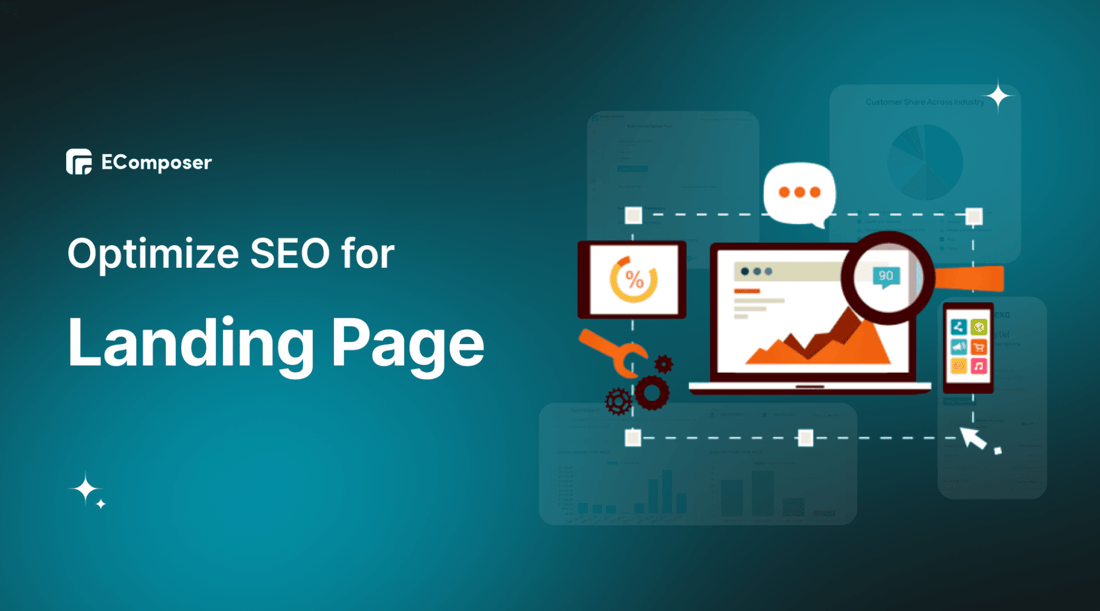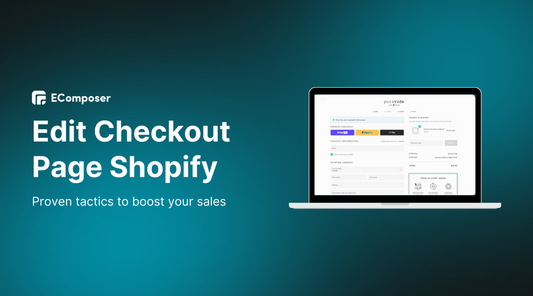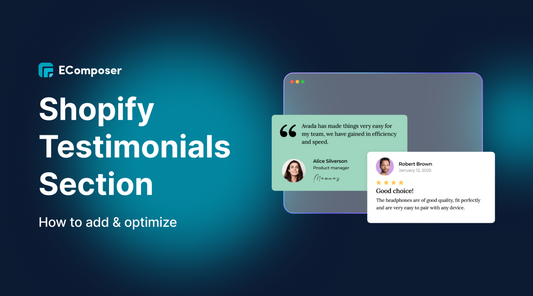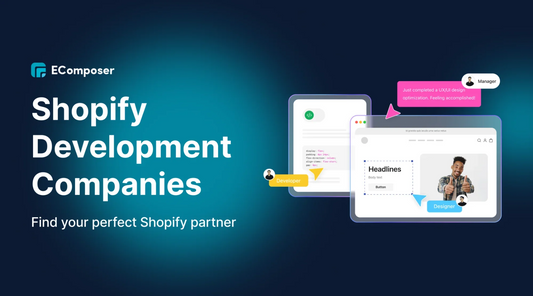10 Tips to Optimize SEO for Landing Page: Step by Step Guide

Table Of Contents
Your marketing staff works tirelessly to create fantastic landing page content that has the potential to captivate your audience and drive sales, but none of it will matter if no one can discover it. That can only be accomplished with a deep grasp of SEO for landing pages.
In fact, even though a landing page's primary purpose is to generate leads through limited-time advertising, optimizing landing pages can help you capitalize on the valuable traffic that you get. You'll miss out if there isn't.
SEO for landing pages works a little differently than the standard SEO you're used to. Therefore, in this blog, we will give tips and a step-by-step guide on how to optimize SEO for your landing page.
Before going into the details, make sure you have built an eCommerce store on Shopify!
What is an SEO Landing Page?

SEO landing pages are ones that have been optimized for search engines, with elements that make them especially appealing to the algorithms that determine whether or not a page is helpful to searchers.
SEO landing pages are often part of a bigger inbound marketing effort aimed at increasing the proportion of overall search traffic in your sector. They efficiently direct people to a conversion event.
If you want your website to rank well in search engine results pages (SERPs), you should prioritize organic search optimization for both new and old content. This is especially true for landing pages, where excellent content is critical for conversion and click-through rates (CTR).
Benefits of SEO Landing Page
 1. Attracts Customer Attention
1. Attracts Customer Attention
Landing pages are helpful because they direct a customer's attention to what you want them to see. When done effectively, landing page SEO may assist attract customers and persuade them to take the required action. This frequently entails joining a mailing list or purchasing a product. In fact, landing pages frequently account for more than half of all Internet transactions.
2. Improves Conversion Rates
Landing page SEO can help boost your website's conversion rates in addition to attracting customers. This implies you'll be able to get more out of your visitors by raising the proportion of them who perform the required action. Conversion rates may be increased by 20% with high-quality landing pages.
3. Saves Time and Money
The landing page SEO is an essential element of search engine optimization. This means that employing landing pages to increase your website's rating will save you time and money. Furthermore, landing pages are an excellent approach to test new marketing techniques without putting your entire website at risk. Many individuals are unaware that adopting landing pages might help them save time and money with their marketing efforts.
10 Useful Tips to Optimize Landing Page SEO

1. Focus on keyword research and analysis
Good SEO for landing pages, like any other sort of search engine optimization, begins with keyword research. You may already have a list of major keywords that you want to target for SEO, which is a wonderful place to start. But that's not enough.
You should also research what's going on in your sector, what your rivals are up to, and what you already know about your present consumers, particularly those who will be most interested in your next campaign.
Choose long-tail keywords that support correct search intent and place them naturally throughout your content. Then, to make your writing even more powerful, include secondary keywords that give context.
In addition, you can use keyword research tools such as Moz Keyword Explorer, Google Keyword Planner, Ahrefs Free SEO Tools, Semrush.
2. Publish your pages to your own domain
When developing landing pages with the best SEO techniques in mind, the URLs you use are important. Always publish your landing pages to your own domain since search engines like Google want to see your actual root domain within that URL rather than something arbitrary and auto-generated.
This also contributes to improved brand consistency and informs your visitors that they are working directly with your organization. It also allows your landing page to benefit from whatever search engine authority you've likely already established for your site.
3. Create an SEO-friendly title
When it comes to SEO for landing pages, the most critical factor to remember is your title. Make sure yours accurately describes the page's content while without being overly lengthy. Because search engines normally display just 60 characters of the title in SERP results, make them count.
Of course, you should put keywords with the highest-quality samples first. Keywords nearest to the left-hand side of your title are prioritized by search engines. If your title has numerous important terms, use vertical bars to indicate which words and phrases belong together.
4. Optimize your landing page URL
The actual URL is the most significant feature in SEO for landing pages after the headline. Publishing your page to your private domain is a good start, but it's not the whole story. Optimizing your URL further helps search engines comprehend where your landing page fits into the overall structure of your site.
As a result, you can use the same optimization strategy for landing pages as you would for other web pages. Keep it brief, because search engines typically truncate URLs longer than 65 characters in SERP results. As with titles, place your most significant keywords as far to the left as feasible, separating thoughts with slashes.
[ecom-global-block]ecom-shopify-trial-block[/ecom-global-block]
5. Craft a concise meta description
The meta description of your landing page has no direct impact on your SERP results, unlike the title or URL. However, it does assist search engine visitors in deciding whether or not to click through to your site, making it a crucial aspect of SEO for landing pages.
The key to outstanding landing page meta descriptions is to make them informative yet brief and use them to tell customers exactly what they will discover if they click the link. Otherwise, most visitors will abandon your website as soon as they arrive, harming your SEO.
6. Optimize your landing page images
The visual aspects of a landing page may be more difficult for Google and other search engines to interpret, comprehend, and categorize. However, you may greatly ease the process by optimizing a few parameters associated with your images.
You should also bear in mind that consumers do look at the picture tab that appears alongside their search results, thus optimizing images may assist SEO significantly. Choose your image's file name with care, keeping it brief but descriptive. To separate words, use dashes. Spend some time selecting the appropriate alt text, as this will show in place of the picture if it fails to load for whatever reason. (The alt text is also used by screen-reading software.)
Read more: How to compress images in Shopify store
7. Implement a link-building plan
Link building is just as vital in SEO for landing pages as it is in any other situation where you want to improve your SERP ranks, so don't overlook it in your approach. Search engines always assess whether other people on the internet think a website is important and valuable, and a backlink is one of the strongest signs.
It indicates that people have not only read and appreciated the content but are ready to stand by it and recommend it to others. To increase backlinking, design your landing pages with shareability in mind. Encourage consumers to share your material on social media by including social media sharing buttons or rewarding shares with features such as a "tweet to download" mechanism.
8. Keep page length consistent
Although the majority of high-ranking material is lengthy, there is no solid proof that it ranks highly due to its length. It's more than likely because it's interesting, well-researched, and full of facts that are actually valuable to its visitors. These factors result in more shares, greater engagement rates, and more backlinks.
Landing pages, on the other hand, are less successful when they are too lengthy. So, instead of obsessing over the length of yours, err on the side of conciseness. If your content is well-optimized, useful, and efficient, it has a good possibility of ranking high in SERPs.
9. Plan your landing content carefully
Because landing pages are intended to generate leads and prime visitors to convert, your on-page material should reflect this. Of course, keeping your visitors' interest so they stay instead of leaving is critical when it comes to SEO for landing pages.
One of the keys to achieving this successfully is to concentrate on the advantages of your product or service. Demonstrate to your audience how amazing their life could be if they give it a go. Keep your language concise, crisp, and easy to grasp because this is what performs best on landing pages. Also, be sure to organize your page for success. Because most visitors don't read landing page material in great depth, a captivating title might help them understand the most critical facts.
Leads will also look at any subheadings you include, as well as your photos, CTA buttons, and other visual aspects, so pay close attention to these things.
10. Keep forms simple and user-friendly
Because landing pages are designed to generate leads, most will have one or more forms for visitors to fill out. The firm behind the page obtains a lead's personal information in return for a digital product of some type - an ebook, a sweepstakes entry, or access to a special bargain.
Visitors to landing pages, on the other hand, are often impatient, and no one like filling out forms. Instead of gathering as much information as possible from your leads, restrict the number of fields on your form to a minimal. (Aiming for four or five is a decent starting point.)
Remember, all you really need to start nurturing a lead is their name and a mechanism to reach them in the beginning. Additionally, keep an eye on your bounce rate. If your landing page forms are lengthy and your bounce rate appears to be exceptionally high, consider limiting the number of entry fields to see if that helps.
5 Steps to Create an SEO-friendly Landing Page
There are many ways for you to optimize SEO for your landing page, but the simplest and most time-saving way is to use a third-party app. On Shopify, now there are many apps that support landing page optimization are released, but it is not easy to choose a really quality application.

In this blog, we will introduce you to one of the top Page Builder apps on Shopify, EComposer - Landing Page Builder. EComposer - Landing Page Builder enables customers to create excellent online stores without any coding experience. It offers a ton of templates and elements to aid in the creation of any type of page, including those that are not offered by Shopify.
Additionally, a live drag-and-drop editor makes it simple to make stunning, expert Landing Pages. And copy and page everything if you wish to blend multiple templates or portions. EComposer also offers a highly capable and enthusiastic 24/7 support team.
Especially, EComposer helps you create SEO Landing Page in just 5 short steps. Follow the detailed step-by-step below:
Step 1: Install and open EComposer
- In the Shopify App Store, search EComposer Landing Page Builder then click Add App
- To activate the use of the app, Install the app to your Shopify store.

- In the Dashboard menu, go to Apps, click EComposer Landing Page Builder.

Step 2: Create a Landing Page
- Click Start Building in the right corner of the dashboard and select Landing Page

- Choose any EComposer template you want by clicking Select a template or click blank template if you want to create your own landing page.

- Then, click Setup page info and select Start Building.

Step 3: Customize your Landing Page
* Option 1: Using EComposer’s prebuilt templates
- Hover over each section of the template, and an editing pen appears, click on it to open the editing section on the left.

- You can change the text in the Content section, adjust the colors or images in the Design section, or customize everything related to display settings like code, background, animation, and more. in the Advanced section.

- Additionally, you can add more elements to your landing page using EComposer.

* Option 2: Using EComposer’s elements to build from scratch
- First, choose a structure you want

- Select the elements by drag-drop them into the desired location.

- Customize in the Content, Design, and Advanced sections as in the first option.

Step 4: Optimize your Landing Page
Click Publish and an editing window will open allowing you to optimize your landing page.
In this window, you are allowed to customize the General and CSS/JS:
- General: Here, you can edit the page title, URL, page visibility, header & footer, meta description, and social sharing image. Apply the tips above to optimize your Landing Page

- Custom CSS/JS: EComposer allows you to customize your CSS/JS code to suit your needs. Note, your landing page only works when the code is entered correctly, so test your code carefully before using it.

Step 5: Save and publish
Once you're satisfied with your edits, click Save and publish to live your landing page. If you don't want to go live, EComposer gives you many other options including Save as draft, Save to library, File import and Export as file.

Read more:
- Successful Landing Page Copywriting:
- High Converting Mobile Landing Page
- How to build Lead Generation Landing Page
- Ultimate guide to Event Landing Page
In a nutshell
If your target audience does not see your landing page, it is pointless. Landing page SEO assists in directing the correct people to your landing page. This boosts lead generation and conversion rates.
We hope the above blog has provided tips and guidelines for creating effective SEO landing pages. If you want more information or want to learn more about EComposer, follow us at ecomposer.io or click on the message icon located in the right corner of the screen.
=================
Add EComposer Next generation page builder Here
Follow Us on Facebook
Join Official Community





















0 comments